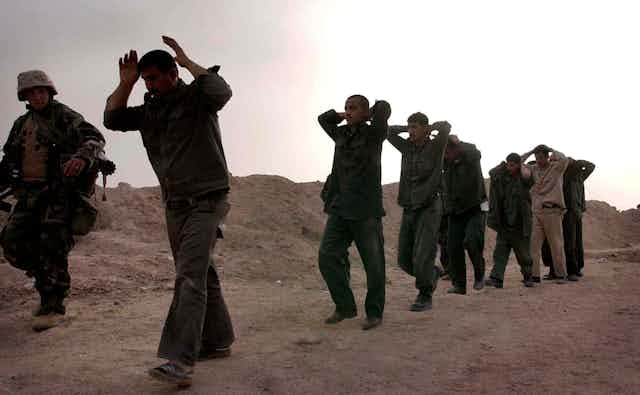At the start of 2022, the right to vote, the rule of law and even the existence of facts seemed to be in grave peril in the United States.
Explanations for this crisis ranged from the decades-long decline of the American middle class to the more recent rise of social media and its unique capacity to spread lies.
In truth, many factors were at play, but the most direct cause of America’s harrowing descent — the one event that arguably set the others in motion — began 19 years ago.
War by choice
On March 19, 2003, George W. Bush and his neoconservative brain trust launched the Iraq war because of the alleged threat of Saddam Hussein’s mothballed weapons. Bush and his advisers believed in using military force to spread American political and economic might around the globe.
It was an ideology both foolish and fanatical, the pet project of a tiny circle of well-connected warmongers. Bush himself had lost the popular vote in 2000 and was slumping in the polls before Sept. 11, 2001.

But no one wanted to look weak after the terrorist attacks, and so, in one of the last bipartisan gestures of the past two decades, U.S. senators from Hillary Clinton to Mitch McConnell voted for war in the Middle East.
Having sold the invasion with bad faith and bluster, the neocons planned it with hubris and incompetence. Against the professional advice of the U.S. military, they sought to destroy Saddam Hussein’s regime with minimal ground forces, whereupon they would dismantle the Iraqi state and invite private contractors to somehow rebuild the place.
At first, their fantasies swept to victory. But by 2004, the country they had shattered began to lash out at both the invaders and itself, and by 2006 the singular disaster of our times began to spread.

Butterfly effects
Some two million Iraqis decamped to Syria and Jordan and even more fled to places within Iraq, where the ghoulish seeds of ISIS began to grow.
When ISIS spread following the U.S. withdrawal from Iraq in 2011, a second wave of refugees sought shelter in Europe. This stoked nationalism and helped propel Brexit to a stunning win in the United Kingdom.

In America, the war caused a two-part reaction, first on the left and then on the right.
After their anti-war movement fell short, progressives nearly despaired before embracing Barack Obama. Of all the factors that made his election possible in 2008, his opposition to the Iraq war did the most to set him apart from his more established rivals.

The election of a Black man with a Muslim name quickly spawned the Tea Party, which rejected traditional conservatism (and neoconservatism) in favour of semi-organized rage at the government Obama embodied. By 2011, elements of the Tea Party had morphed into the risible birther movement, according to which Obama was a Kenyan-born radical intent on destroying America.
The rise of Trump
When Obama released his birth certificate to quell the nonsense, the spiritual leader of the birthers, Donald Trump, refused to apologize. Instead, Trump kept telling the same lie, and the Tea Party adherents morphed into his Make America Great Again base.
Who could imagine such a man in the White House? He had toyed with the idea in 2000, and no one had cared. Evidently, his strong appeal to white nationalists didn’t always make him a serious contender for the presidency.
Sixteen years later, however, Trump combined his brash bigotry with repeated attacks on the Iraq war and related appeals to America First isolationism.

“They lied,” he noted of the neocons. “They said there were weapons of mass destruction; there were none. And they knew there were none.” That resonated far beyond his alt-right base.
Put simply, Trump’s rise is impossible to imagine without the chain reaction that began over the skies of Baghdad and ended in toxic fallout over Washington. He was the Obama of the right, the man who drew the disillusioned masses into an electoral force that broke all the pre-2003 rules — except the anti-majority rules of the Electoral College, to which he owed his victory even more than Bush.
The spell is broken
In 2019, one year after grovelling to Vladimir Putin at a summit in Finland, Trump tried to bully the new president of Ukraine, Volodymyr Zelensky, into making up dirt on Joe Biden.

This delayed U.S. weapons transfers to Ukraine and undercut Zelensky’s authority.
As always, Trump saw nothing wrong in smashing democratic norms or siding with dictators. He’s a nihilist as well as a bigot. He assumes the world belongs to those who take the most from it, and therefore that Putin, a fellow alpha dog, is a “genius” for invading Ukraine while lesser men run the U.S. and other democracies.
Trump’s hard-core base agrees.
But the horrifying spectacle of aggressive war seems to have broken his dark spell over everyone else, including most Republican leaders in the Senate. It’s as if Americans now see what they were in danger of becoming — and suddenly remember that they do believe in something other than brute force and endless lies.
The world can only hope it’s not too late.

